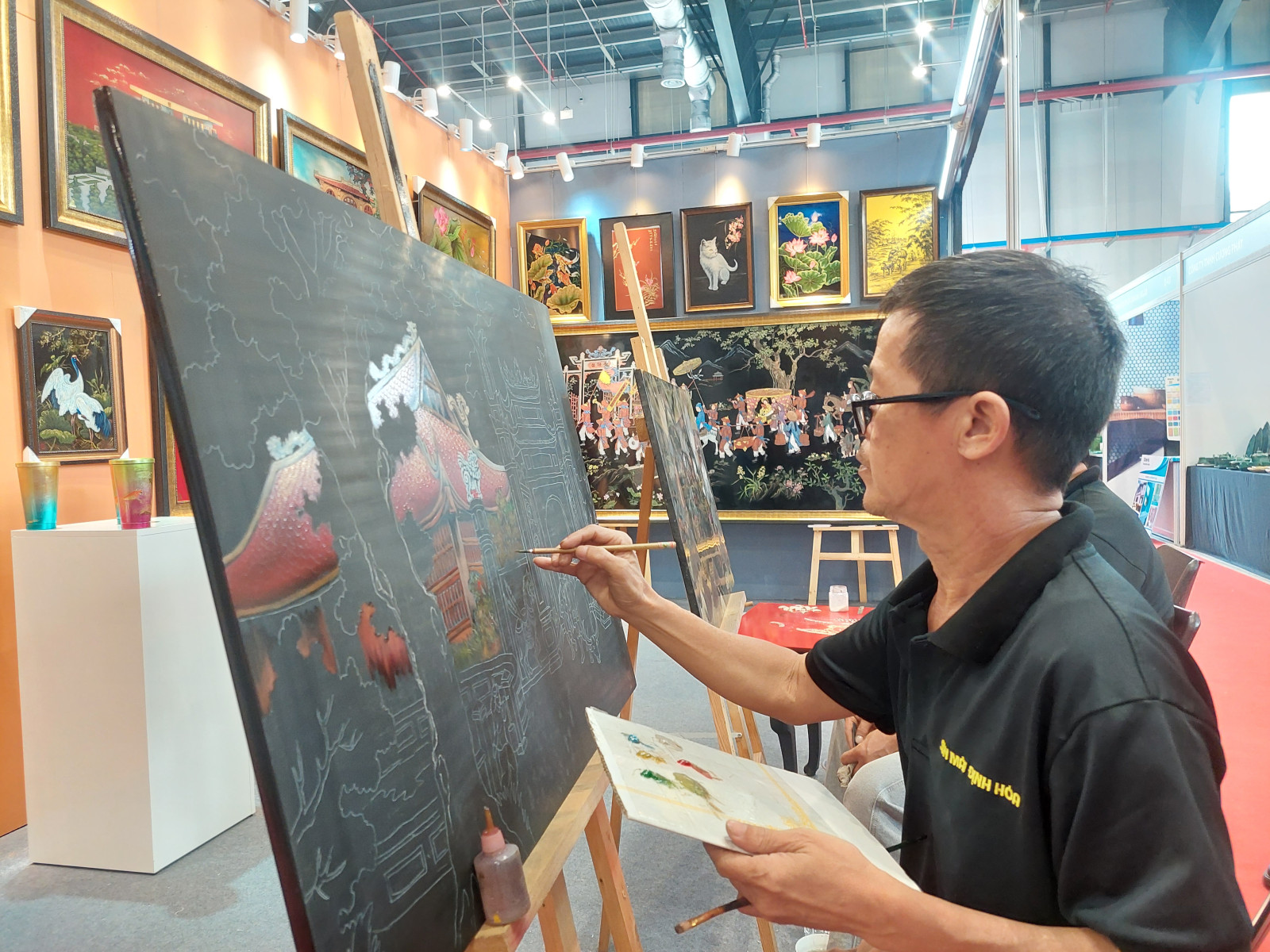Binh Duong lacquer showcases its value
Binh Duong province is well-known not only for its modern industrial parks, Lai Thieu fruit gardens, and Minh Long ceramics but also for the sophisticated and unique handicraft products crafted by generations of skilled artisans. Traditional handicrafts in Binh Duong provide a stable income for craftsmen and create a unique cultural identity for the region, encompassing significant historical values, including the lacquer craft.

Lacquer products from Tuong Binh Hiep craft village attract both domestic and foreign customers to visit, learn about the production process, admire the craftsmanship, and shop.
Long road of development
Lacquer craft is a step up from painting craft or also known as lacquerware craft. Painting and decorating with paint is a long-standing folk craft of our people. According to documents and oral tradition, during the reign of King Le Nhan Tong (1443), Mr. Tran Lu, also known as Tran Thuong Cong, was the first person to create the lacquerware profession and was honored as the founder of this profession. Through many historical events, the traditional lacquer craft still exists and develops today, contributing to the cultural identity of Vietnam.
In Binh Duong, during the land reclamation process, people from the North and Central regions brought with them traditional crafts. Initially, this profession was only self-sufficient or exchanging products to serve daily-life activities. The painting profession is mainly concentrated in Tuong Binh Hiep village (Tuong Binh Hiep ward, Thu Dau Mot city today). Initially (late 1920s), in Tuong Binh Hiep there were only a few households specializing in making gilded lacquer and mixing lacquer. Later, Tuong Binh Hiep craft village gradually developed, and clay painters of Thu land became famous and created more and more diverse products.
In 1901, the French established the Thu Dau Mot Native Fine Arts School, commonly known as the Ba Nghe School (now the Binh Duong Fine Arts and Culture Junior College), mainly training in professions such as carpentry, wood carving, wood inlay, mother-of-pearl inlay, fine art lacquerware, bronze casting, decoration... However, the peak of lacquer craft development was from the 50s to the 80s of the last century. This period marked the rise of Tuong Binh Hiep lacquerware through products originating from Thanh Le lacquerware workshop founded by two artisans Truong Van Thanh and Nguyen Van Le.

At Dinh Hoa Lacquerware Factory, products must go through dozens of stages before reaching consumers.
The feature of a hundred-year-old craft village
Tuong Binh Hiep lacquer craft village is one of the traditional craft villages in Vietnam, famous throughout the country and considered the cradle of Binh Duong lacquer. Mr. Le Ba Linh, Vice President of the Binh Duong Lacquer - Sculpture Association, said that according to history, the lacquer craft in Binh Duong appeared quite early, at the end of the 17th century. At first, lacquer products only served the daily life of families and nearby communities. Gradually, they became a profession because they were able to trade and exchange products with other local residents across the country, especially in the six provinces of the South.
In the 1960s, the lacquer craft began to develop, "Everyone made lacquer, every household made lacquer." At that time, in Thu Dau Mot area, there were lacquer streets such as Phu Cuong, Chanh Nghia, Chanh Hiep. In particular, the lacquer craft villages of My Hao, Tan An, Tuong Binh Hiep... were quite bustling and known by many customers inside and outside the province. The golden age of Tuong Binh Hiep lacquer craft village was in the 80s and 90s of the 20th century. During this period, the craft village had over 400 households producing lacquer, with over 90% of the population entering this profession. Products were sold as soon as they were produced, and people's income increased.
Tuong Binh Hiep lacquer village has made significant contributions to the economic, cultural, and social life of the province. Therefore, Tuong Binh Hiep Lacquer Craft Village was recognized as a traditional craft village by Binh Duong Provincial People's Committee under Decision No. 3855 in 2008. In 2016, the lacquer craft in Tuong Binh Hiep was officially included in the list of national intangible cultural heritage by the Ministry of Culture, Sports and Tourism. This is a great honor and a well-deserved recognition of the contributions of lacquer craftsmanship. This event reaffirms the importance and reputation of Binh Duong lacquer overall, and specifically highlights the Tuong Binh Hiep lacquer brand in the market.
|
In the years after the Renewal, Tuong Binh Hiep lacquer continued to develop. Over many generations, the establishments in the craft village still retain their traditional beauty, which is sophistication, gentleness, elegance, and imbued with Asian characters. Lacquer products are created using various expressive techniques, including traditional lacquer painting, thinly painted lacquer, hollowed lacquer, embossed lacquer, and eggshell or mother-of-pearl inlaid lacquer. These methods can be applied to a range of materials such as wood, ceramics, and bamboo. As a result, lacquer products continue to be exported and successfully penetrate many demanding markets. |
By T.Phuong, T.Truc - Translated by Ngoc Huynh

